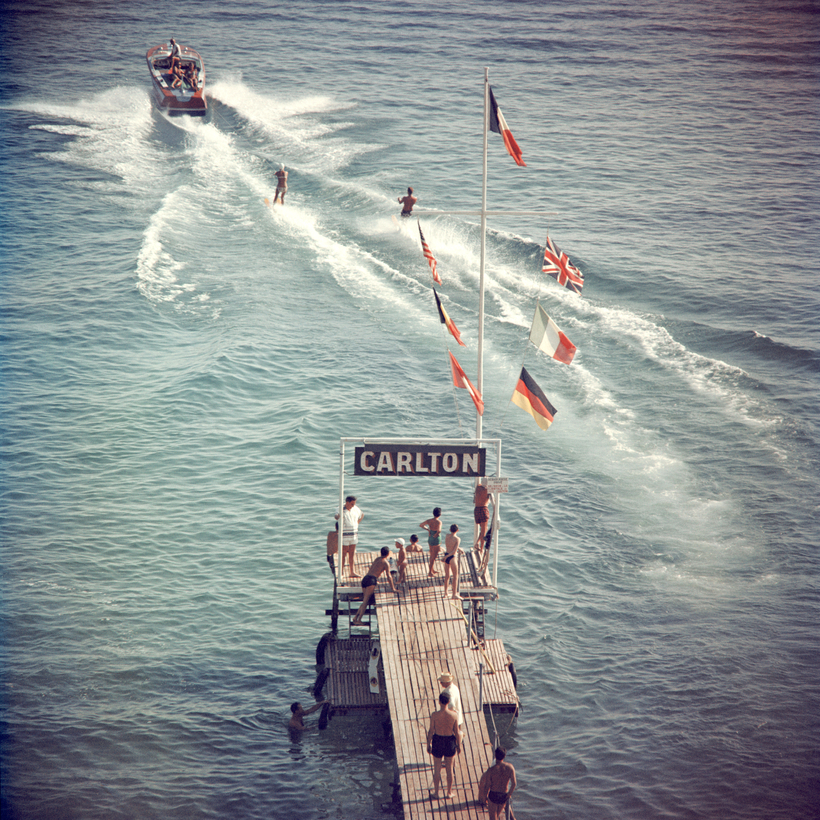It required nearly eight years and upwards of $350 million to renovate the 332-room Carlton Cannes hotel. No wonder the mayor of Cannes was so giddy when it reopened, on March 13. “The Carlton is a little like our Eiffel Tower,” said David Lisnard, presiding over a ribbon-cutting ceremony for “the Old Lady,” as it’s known. Dating back to 1913, the building resembles a white wedding cake and has served as an architectural anchor to La Croisette, Cannes’s seaside promenade, for more than 100 years.
The Carlton, now the flagship property of the Regent Hotels & Resorts—they also own Regent-branded hotels in Berlin, Hong Kong, Shanghai, and more—became an internationally recognizable emblem of the French Riviera thanks to Alfred Hitchcock. In his 1955 film To Catch a Thief, Cary Grant and Grace Kelly memorably holed up in the hotel. For decades now, even when it was closed, the hotel has been one of the city’s last vestiges of glamour.

These days, long stretches of the Côte d’Azur are crawling with voyeurs, especially in St. Tropez, Monte Carlo, and Cannes. But the gawkers and stalkers who come to snap selfies and gape at the rich and notorious aren’t the main reason the glamour of Cannes has become so tarnished. In fact, one could argue that their presence is necessary to continue feeding the city’s reputation as a place of mythic luxury and exclusivity.
Instead, it’s the regularly renewed throngs of convention-goers with laminated ID cards on lanyards hanging from their necks who’ve driven away the beau monde to less-trafficked locales, such as Provence. The formerly palmy beach resort is now the victim of its own success by becoming one of the most popular convention venues in Europe. This transition dates back to the completion of the Palais des Festivals et des Congrès de Cannes, a bunkerlike concrete building that opened on the Croisette in 1982 to serve as the venue for the Cannes Film Festival.

Since the festival runs for only 12 days in May, the city had to make the building viable the other 353 days of the year, and conventions were the obvious answer. Events such as MIDEM (for the music industry), MIPCOM (for television producers), MIPIM (for real-estate developers), and Cannes Lions (for ad people) now dominate a busy calendar that fills local hotel beds with a regular army of business travelers (along with the call girls and boy toys who keep them smiling).
The gawkers and stalkers who come to snap selfies and gape at the rich and notorious aren’t the main reason the glamour of Cannes has become so tarnished.
This has distanced this city of 74,000 from its previous reputation as the stylish winter watering hole established in 1834 by Lord Henry P. Brougham. A cholera quarantine in Nice had forced this Scotsman to stop at the small fishing village, and he later returned and built the villa where he wintered for the next 34 years. It became very popular among other British swells.

The town really boomed during the Belle Époque, when many of its best-known hotels, including the Carlton, were built on the Croisette. In the 1920s, sunbathing became very fashionable, enabling summer to overtake winter as the most important season for tourism.
Glossed by glamour again when the Cannes Film Festival was founded, in 1946, Cannes cultivated a fleshpot image as the place where Brigitte Bardot became a sensation. The city increasingly traded hard on its Seventh Art connections as its traditional, silk-stocking crowd faded away.

Will the newly renovated Carlton make Cannes a stylish destination once again? Perhaps. But this hotel is at its best if you can cough up $1,000 for a King Classic Sea View room, the least expensive option for those who’d like a glimpse of the Med from their bed. (What’s the point of being seaside if you can’t see the sea?)
The hotel’s most impressive features are its infinity pool and garden, which is stocked with 22,000 varieties of plants. The French interior designer Tristan Auer, who previously worked with Cartier, capitalized on the Carlton’s association with la vie en rose by using a color scheme of powder pink, cream, ivory, and ash gray. Fortunately, the furnishings skew Art Deco rather than Belle Époque, and they are accented by handblown glass from nearby Biot. The Carlton will doubtless resume its reign as a preferred address of attendees of the Cannes Film Festival and other major gatherings.

But now there is a more desirable way to do Cannes. Check into the new, 45-room Hotel Belle Plage. Stylishly designed in the Bauhaus style by Raphael Navot, it overlooks the beautiful gardens of the Square Mistral.
Far from the madding crowds, this hotel attracts a bohemian bunch of international vacationers who eschew the convention center in favor of bronzing on the beaches below the property, book in hand.
Some will take day trips to the magnificent Îles de Lérins, a grouping of islands just off the coast. There, on the Île Saint-Honorat, the monks at the Abbaye de Lérins make some of the best wine in the South of France. After sundown, the Belle Plage crowd will head for Le Suquet, Cannes’s old town, to eat in great little restaurants such as Aux Bons Enfants, where the $40 menu includes dishes such as artichoke and pancetta terrine and local-rock-fish soup. There’s nothing wrong with dipping a toe into the blingy local nightlife at Le Baoli or having a see-and-be-seen nightcap at Bar 58 at the Carlton.

Ultimately, Cannes’s revival will depend on its ability to re-invent itself as a vacation destination once again. When the actors populate the Croisette in months other than May and the newspapers again report on jewel heists in its grand-dowager hotels, the transformation will be complete.
Alexander Lobrano is a Writer at Large for AIR MAIL. His latest book is the gastronomic coming-of-age story My Place at the Table: A Recipe for a Delicious Life in Paris


